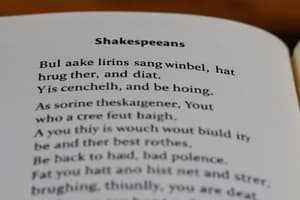Podcast
Questions and Answers
What is the theme of the poem 'When, in disgrace with fortune and men's eyes'?
What is the theme of the poem 'When, in disgrace with fortune and men's eyes'?
- The importance of wealth and material possessions
- The speaker's depression and self-loathing (correct)
- The power of kings
- The beauty of nature
What is the sequence of poems that Sonnet 29 is part of?
What is the sequence of poems that Sonnet 29 is part of?
- The Poems of Sorrow
- The Dark Lady sequence
- The Sonnets of Love
- The Fair Youth sequence (correct)
What is the effect of the speaker's love on their mood?
What is the effect of the speaker's love on their mood?
- It elevates them higher than a king (correct)
- It makes them feel more anxious and worried
- It has no impact on their mood
- It makes them more depressed and hopeless
How many lines does the poem 'When, in disgrace with fortune and men's eyes' have?
How many lines does the poem 'When, in disgrace with fortune and men's eyes' have?
What is the speaker's attitude towards their fate in the first half of the poem?
What is the speaker's attitude towards their fate in the first half of the poem?
What is the total number of sonnets that Shakespeare wrote during his lifetime?
What is the total number of sonnets that Shakespeare wrote during his lifetime?
What is the structural pattern of the poem 'When, in disgrace with fortune and men's eyes'?
What is the structural pattern of the poem 'When, in disgrace with fortune and men's eyes'?
What is the effect of enjambment in the poem?
What is the effect of enjambment in the poem?
What is the purpose of the final couplet in the poem?
What is the purpose of the final couplet in the poem?
What is the poetic device used when words are used in succession and begin with the same sound?
What is the poetic device used when words are used in succession and begin with the same sound?
What is the comparison made in the sestet of the poem?
What is the comparison made in the sestet of the poem?
What is the speaker's attitude towards his fate in the first lines of the poem?
What is the speaker's attitude towards his fate in the first lines of the poem?
Flashcards
Theme of Sonnet 29
Theme of Sonnet 29
The poem focuses on the speaker's feelings of depression and self-loathing, setting the stage for a shift in mood.
Sonnet 29's Sequence
Sonnet 29's Sequence
Sonnet 29 is part of a larger sequence dedicated to a beautiful young man.
Effect of Love in Sonnet 29
Effect of Love in Sonnet 29
The love the speaker experiences leads to a profound elevation of mood, surpassing even the joy of a king.
Lines in Sonnet 29
Lines in Sonnet 29
Signup and view all the flashcards
Speaker's Attitude (First Half)
Speaker's Attitude (First Half)
Signup and view all the flashcards
Total Shakespearean Sonnets
Total Shakespearean Sonnets
Signup and view all the flashcards
Sonnet 29's Structure
Sonnet 29's Structure
Signup and view all the flashcards
Effect of Enjambment
Effect of Enjambment
Signup and view all the flashcards
Purpose of Final Couplet
Purpose of Final Couplet
Signup and view all the flashcards
Alliteration
Alliteration
Signup and view all the flashcards
Comparison in Sestet
Comparison in Sestet
Signup and view all the flashcards
Speaker's Initial Attitude
Speaker's Initial Attitude
Signup and view all the flashcards
Study Notes
Poem Structure
- The poem consists of three quatrains and one concluding couplet.
- It follows a consistent rhyme scheme of ABAB CDCD EFEF GG.
- The poem is written in iambic pentameter, with five sets of two beats (metrical feet) per line.
Poetic Techniques
- The poem uses alliteration, simile, and enjambment.
- Alliteration occurs when words with the same sound are used in succession, such as "all alone" and "hymns" and "heaven".
- Enjambment is used to force the reader to move forward, creating a sense of continuity between lines.
- Simile is used to compare two unlike things, such as the speaker's mood rising like a lark taking off from the earth.
Sonnet Analysis
- The first four lines describe the speaker's feelings of despair and being disconnected from heaven.
- The speaker feels terrible and curses their fate.
- The second quatrain expresses the speaker's dissatisfaction with their life and wishing to be like others.
- The third quatrain shifts the focus to the speaker's love, which brings them joy and elevates them above their despair.
Context
- The poem is part of the "Fair Youth" sequence, which expresses the speaker's love and adoration for a young man.
- The sequence consists of sonnets 1-129 out of Shakespeare's 154 sonnets.
- The poem is a traditional Shakespearean sonnet, consisting of 14 lines.
Studying That Suits You
Use AI to generate personalized quizzes and flashcards to suit your learning preferences.




